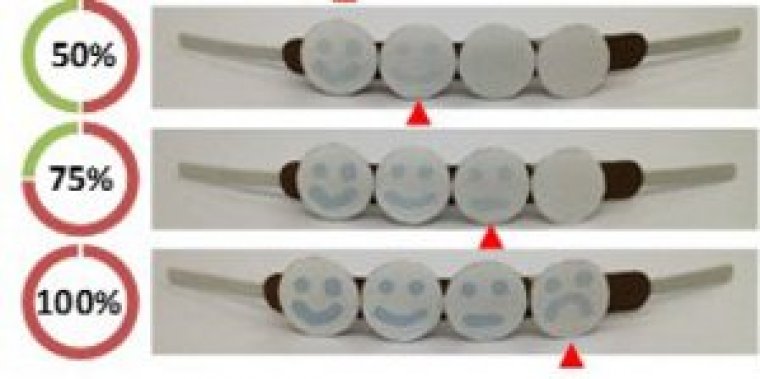| News / Science News |
New wristband provides personalised and real-time tracking of UV exposure
Researchers from the University of Granada and RMIT University in Melbourne have developed personalised and low-cost wearable ultraviolet (UV) sensors that warn users when their exposure to the sun has become dangerous.

The emoticon faces on the wristband successively “light up” as exposure to UV radiation increases. Foto: Universidad de Granada
The paper-based sensor, which can be worn as a wristband, features happy and sad emoticon faces—drawn in an invisible UV-sensitive ink—that successively light up as you reach 25%, 50%, 75% and finally 100% of your daily recommended UV exposure.
The research team have also created six versions of the colour-changing wristbands, each of which is personalised for a specific skin tone — an important characteristic given that darker people need more sun exposure to produce vitamin D, which is essential for healthy bones, teeth and muscles.
Skin cancer, one of the most common types of cancer throughout the world, is primarily caused by overexposure to ultraviolet radiation (UVR). In regions such as Australia, where the ozone layer has been substantially depleted, it is estimated that approximately 2 in 3 people will be diagnosed with skin cancer by the time they reach the age of 70.
Other sensors currently available on the market only measure overall UV radiation, without distinguishing between UVA, UVB and UVC, each of which has a significantly different impact on human health. In contrast, the new paper-based sensor can differentiate between UVA, UVB and UVC radiation.
Prolonged exposure to UVA radiation is associated with skin ageing and wrinkling, while excessive exposure to UVB causes sunburn and increases the likelihood of skin cancer and eye damage.
The sensor paper they created features a special ink, containing phosphomolybdic acid (PMA), which turns from colourless to blue when exposed to UV radiation. They can use the initially-invisible ink to draw faces—or any other design—on paper and other surfaces.
Depending on the type and intensity of the UV radiation to which the ink is exposed, the paper begins to turn blue; the greater the exposure to UV radiation, the faster the paper turns blue.
By tweaking the ink composition and the sensor design, the team were able to make the ink change colour faster or slower, allowing them to produce different sensors that are tailored to the six different types of skin colour. (University of Granada)
YOU MAY ALSO LIKE



